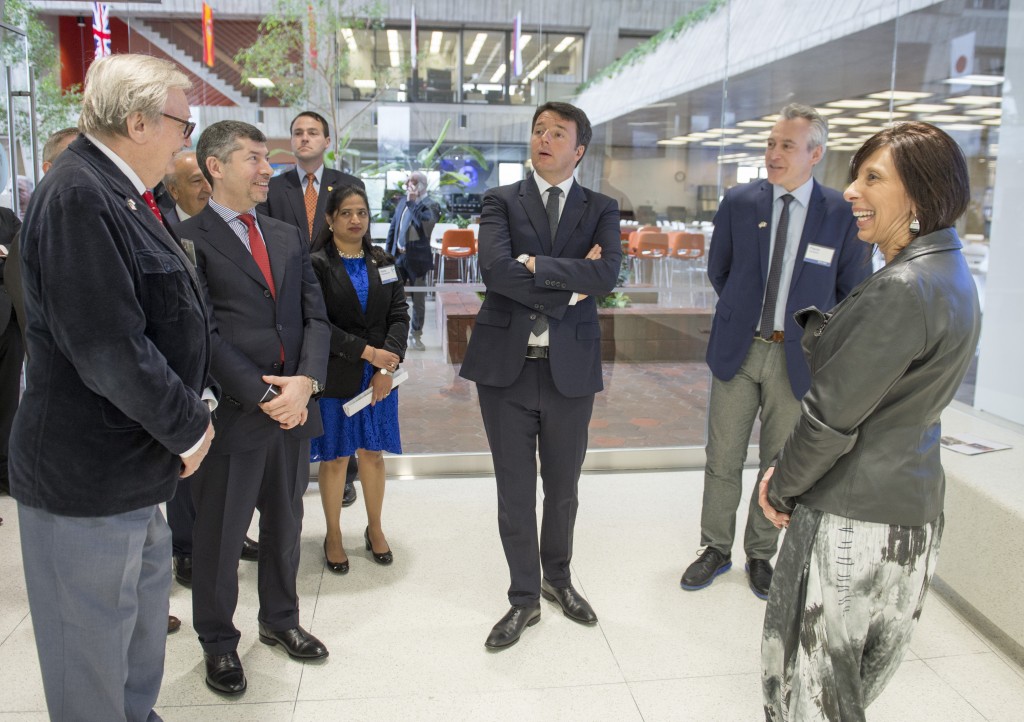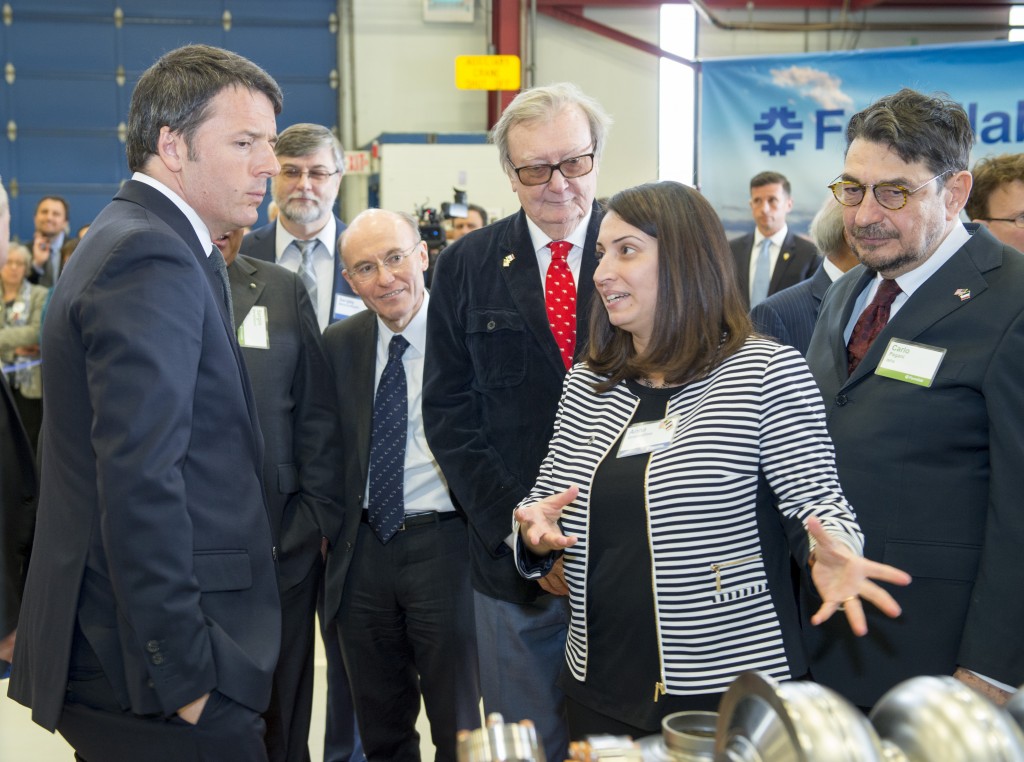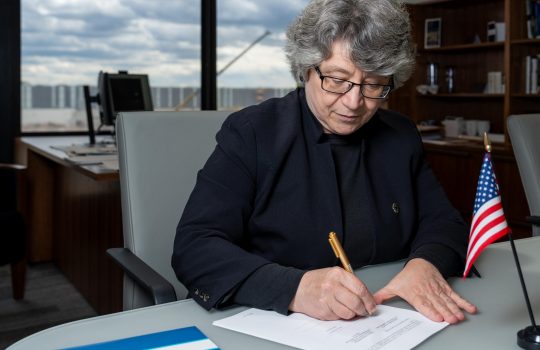Today Italian Prime Minister Matteo Renzi visited Fermi National Accelerator Laboratory to celebrate nearly four decades of collaboration between Fermilab and Italy. Renzi met with Fermilab Director Nigel Lockyer and Italian researchers to discuss the many contributions Italy — and Italian scientists, engineers and students — have made and continue to make to Fermilab and to particle physics research.
While at Fermilab, Renzi toured an operations center that serves as a hub for Fermilab’s neutrino experiments and a technical area where high-tech, Italian-made particle accelerator components are assembled.
“The world of research is now global and interconnected,” Renzi said, addressing a group of about 50 Italian scientists, engineers and students gathered to welcome him to the lab.
As a significant contingent on Fermilab’s CDF experiment, Italian scientists were among those who discovered the top quark in 1995. It was a major success of the relationship with the Italian National Institute of Nuclear Physics, or INFN, that started in the early 1980s.
“Our involvement is not only at the level of the physics, but also at technology, and also our industry,” said INFN Vice President for Research Antonio Masiero. “We think that, working together, we can have a mutual benefit from both institutions.”

Italian Prime Minister Matteo Renzi (center) tours the Remote Operations Center West at Fermilab and learns about neutrinos. Photo: Fermilab
Fermilab scientist Luciano Ristori noted that one of Italy’s — and the world’s — great physicists made an important contribution to the laboratory in nothing less than its very name.
“We are all extremely proud of the fact that this important American research laboratory is named after the great Italian Enrico Fermi,” Ristori said, addressing Prime Minister Renzi.
Prime Minister Renzi was accompanied by Italian officials including Ambassador Armando Varricchio, Deputy Minister of Economic Development Ivan Scalfarotto, and Consul General of Italy in Chicago Adriano Monti. Prominent scientists from Italy traveled to Fermilab to celebrate the occasion, including Carlo Rubbia, a Nobel Prize-winning physicist, senator-for-life of the Italian Republic and former director general of the European laboratory CERN; Antonio Masiero, INFN vice president for research; and Sergio Bertolucci, INFN coordinator for the future Deep Underground Neutrino Experiment, or DUNE, to be hosted by Fermilab.
Italian contributions to Fermilab are felt throughout the laboratory’s R&D programs. Rubbia developed the revolutionary liquid-argon detector technology behind several Fermilab neutrino experiments, including the flagship experiment DUNE, enabling researchers to study neutrino interactions in a new way.
“Fermilab helps CERN bring forward its flagship program, the LHC,” Bertolucci said. “CERN helps Fermilab to bring forward its flagship program, DUNE. And all the funding agencies, like INFN in Italy, they are working on both projects. It’s a nice synergy.”
Italian institutions have strong, ongoing partnerships with DUNE, its supporting Long-Baseline Neutrino Facility and Fermilab’s Short-Baseline Neutrino Program. Fermilab will reuse the detector for Rubbia’s ICARUS neutrino experiment, being upgraded at European laboratory CERN, which ran at the Italian Gran Sasso Laboratory from 2010-14.

Fermilab scientist Anna Grassellino explains accelerator technology on display at the laboratory’s Technical Campus to Italian Prime Minister Matteo Renzi. Photo: Fermilab
“Italy is the beginning of a story, which is becoming a major American story, with neutrinos,” Rubbia said. “So I’m very happy to see how things are developing.”
Italy also plays a major role in Fermilab’s accelerator R&D. The Italian company Ettore Zanon is one of the few in the world capable of manufacturing the superconducting cavities — structures that impart energy to particle beams — designed at Fermilab for next-generation accelerators.
The superconducting magnets that will be used in Fermilab’s Mu2e experiment were designed in a fruitful collaboration between Fermilab and INFN Genoa. The partnership has yielded prototypes that can produce a magnetic field 20 times stronger than their current counterparts.
Young Italian scientists and engineers have had a major positive impact on Fermilab research, including advances made by interns who come to Fermilab through the Italian Graduate Students summer program, which has seen 400 students study at Fermilab over its 30-year history.
“You find at Fermilab that of 2,000 people, 130 are Italians,” Renzi said. “Research teams here are headed by Italians, and they are doing a great job. The important thing for us is to give Italians the opportunity not only to show the value of ‘made in Italy’ technology, but also to show the skills Italians learn in Italy. Most of these people graduated from Italian universities.”
Before departing Fermilab, Renzi met many members of Fermilab’s Italian community, including scientists, engineers, technicians and students, who will continue to strengthen the bonds between the laboratory and Italy into the future.
“There’s a special relationship between Italy and the U.S., and in particular between the science that’s taking place in Europe, at CERN, at Gran Sasso and also at Fermilab,” Lockyer said. “The Prime Minister said he could feel the passion for our science here. The future is looking great.”



